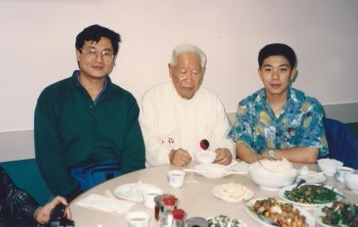Master Feng Guo An (Gordon Feng)
And his unique approach to Yang Tai Chi

Taiji is the application of general Taoist principles and ideas in the context of human motion and physical conflict. One might say that Taiji is principally a means for cultivating an understanding of humanity in its complexity, and Taiji Chuan is the part that addresses human energy and movement. Because Taiji uses qì (气), and most people only use force (lὶ, 力) to move or fight, Taiji operates effectively at a different metaphysical level than force and thus is able to control force. At its most profound and effective level, Taiji is the internalizing of a set of principles governing the use of body, energy and mental intent to affect motion, stillness and balance.
These principles and ideas allow the practitioner to use energy and yì (意) to control his or her opponent, and not use muscle or force. This makes the Taiji practitioner appear to be able either to stand strong like a tree or a mountain, or move effortlessly against opposition like a river or the wind. These are things you can experience. Pushing against a casually standing practitioner is like pushing against a solid immovable object. Conversely, the practitioner can brush the largest opponent aside without using force. This is because Taiji does not use muscle.
Various past practitioners have developed great skill in Taiji using internal energy, but typically they do not have and do not present a complete system which will allow you to establish and expand your practice. I started practicing Taiji when I was 16 and lived in Shanghai. Master Fu Zhongwen, a famous student of Yang Chengfu, lived on my street and for 10 years I practiced with him or his son at his house nearly every day, while I pursued my education in engineering. In that time, Master Fu imparted to me a key to experiencing internal energy.
Expanding on that insight, and using certain ancient Taoist texts and taking an engineer’s approach to the meanings of the Yin/Yang symbol, the xiān tiān (先天) & hòu tiān (后天) bā guà (八卦), the 9 Palaces (jǐu gōng, 九宫), the 5 “elements” (wǔ xíng 五行), and Chinese medical principles, I understand how they harmonize for use in practice. I have constantly worked with students for the last 30+ years and have tested my approach in practice
This is why I say that Taiji is a set of principles and ideas that you must incorporate into your thinking and movement so that you may become “energy led” instead of “body led”. It is universal and not exclusive to any particular form or any particular school. It is a set of practices and principles you can incorporate into any movement set to use those movements with powerful internal energy instead of force.
I have helped many students understand what is holding back their internal development, whether it’s body position, energy cultivation, or misunderstanding the principles of use or engagement. Within a short time I can identify the deficiencies in your practice and help you overcome them. And then, as new ones develop, help you overcome those as well. Practiced correctly, Taiji has no end. You can continue to practice and improve throughout your life. However, it is also very easy to go off on the wrong path, to use force, to miss balance, to incorrectly use yì (意), the gift of stillness (yīn, 陰) and movement (yáng, 陽) and therefore not improve in this essential way.